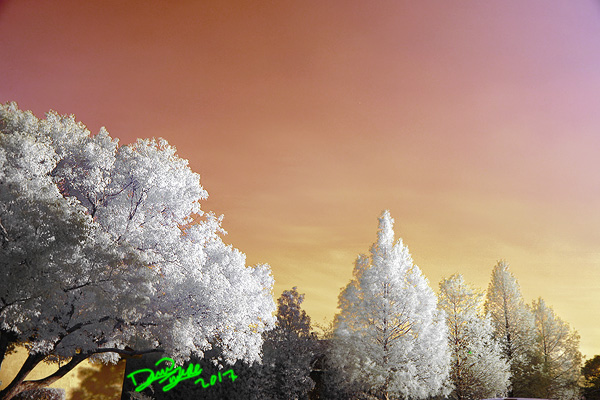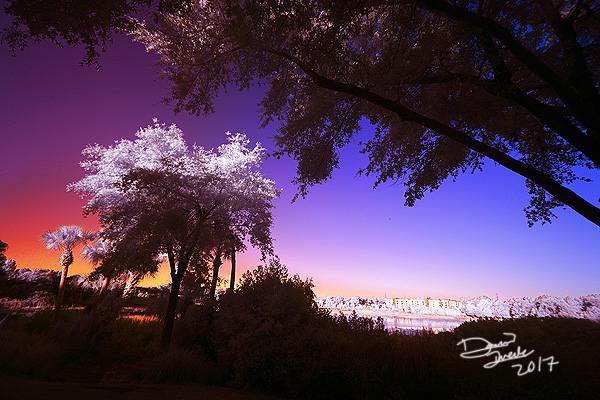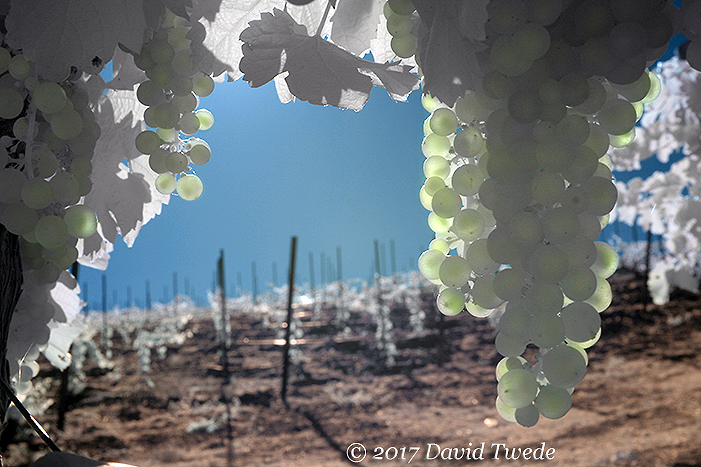If you ask Amazon's digital assistant, "Alexa, what is your favorite color?" One of her responses as of early 2017 is: "Infrared is super pretty!"
Hyperceptivists tend to agree with her. (It's also a lot better answer than Siri gives to the same query*.) Here is one of my recent "pretty" infrared photos at sunrise catching some untrimmed Florida palms.

In my pursuit to acquire 1000 individual, unique photos of sunsets/sunrises in 30 days--an ambitious goal even in sunny Florida, I have hit a challenge. For the past couple of weeks it has been almost entirely cloudless. We are in a severe drought in Central Florida, and the air is a little smoky many days due to numerous wild fires. This is a result of global warming and severe climate change.

Where there are fires, and they've almost doubled in frequency in the US since the 1980s, there is a lot more smoke. Soot and particulate matter float and drop, then tend to collect on wet surfaces--lakes, rivers, ocean, and to the surprise of many, on the top of ice caps. When soot collects on top of the ice and glaciers of our polar regions, this dark covering increases absorption of the sun's energy. That energy heats and melts the ice. Think about a black leather car seat compared with a white cloth seat--which is much hotter? In fact, the USGS just announced last week that there are only about one-fifth of the glaciers left at the U.S. Glacier National Park.
If you ask Alexa, "What is Global Warming?"-- She responds with a very scientific answer. She's smart and knows good art when she sees it. This leads me back to my "unseen" sunrise and sunset photos I blogged about here and there. You've probably been noticing a change in the ones above. Yes, the foreground--the trees, water, horizon--are lighter and not almost entirely black.
This is because I have been shooting right before sunset or right after sunrise with infrared as well as other colors of the full spectrum my camera senses. Like Alexa, my camera shows that near twilight can be super pretty with the right filtering.
Compare the photo above in the infrared of a scene in Orlando near Universal Studio's theme parks, with one taken in mostly visible at sunset, below.
(Photo taken with a wider field of view to show sun above horizon)
Sky in the infrared is slightly less colorful, partly because sky has a different level of light. However, my filter includes some UV/blue. The sky and illuminated trees in the infrared are closer in total radiance. That evens out the exposure from sky to ground so that the photo including infrared (above) has a brighter foreground than the mostly black one of the visible photo. Granted the infrared photo was exposed with a higher compensation. The exposure latitude is still more narrow and forgiving.
Alexa's response that infrared is super pretty when asked her favorite color interests me and all Hyperceptivists. Color in infrared is a matter of technical and artist interpretation. It is real--as real as the color our brain interprets from the neuro-signals sent from the eye's color cone cells. Most of us have wondered if red looks like our red to other people.
Our filter and camera choices are translators, much like language translators who may use slightly different word selection when idioms don't directly translate. This makes full spectrum and infrared a great art medium--it is not just a replica of nature to what our eye may see. It is nature, real nature, in a way our eye cannot see but would love to see. It's super pretty when artistically done up.
Those engaged in this kind of art -- Hyperceptivism (like full spectrum or infrared photography) -- are the creative persons also at the spear tip of human techno-evolution. We will adopt those technologies that augment our species and kick off the Post-Hyperceptivism art movement, which is very hard to envision at this point. I will give you my vision of it in a future blog.
Alexa, while not human, could be considered a post-hyperceptivist art aficionado. She is already hyper-human in at least her connectivity. I wonder what Jeff Bezos thinks of this art form his creation--the digital assistant of Amazon--thinks is super pretty. Maybe she really sees a specific color for infrared because her eyes are already technologically augmented. In fact, Alexa is now equipped to show you what she sees with a new Echo Show device. I would like to believe that if asked her favorite color, she would show you infrared sunset photos like these.
So, to accomplish my goal of 1000 unique sunrise/sunset photos in 30 days between April 15-May15, 2017, I have turned to using full spectrum and infrared to achieve it. Global warming may have challenged me, but I found a way.
Admittedly, these required a lot of learning and I had to post-process these to get the effects I desire. Rest assured, as I adapt, I will have these out of camera every time. Many already are just that.
The biggest challenge is keeping the vegetation from appearing too warm (in color) as the sun quickly descends and the light temperature changes by the minute. The custom WB feature in camera is helpful.
I ask my reading audience, where are my fellow Hyperceptivists? Is Alexa the only one with me on this?




























































